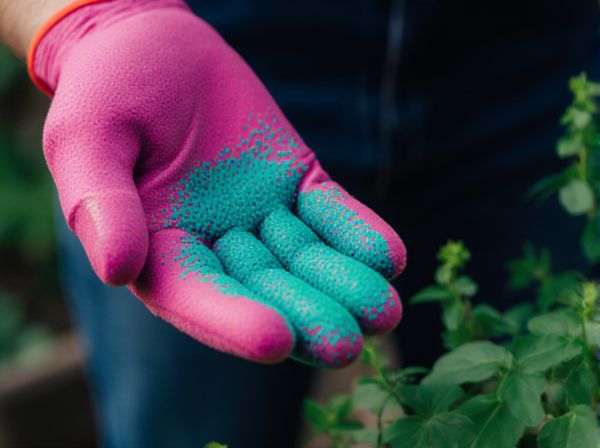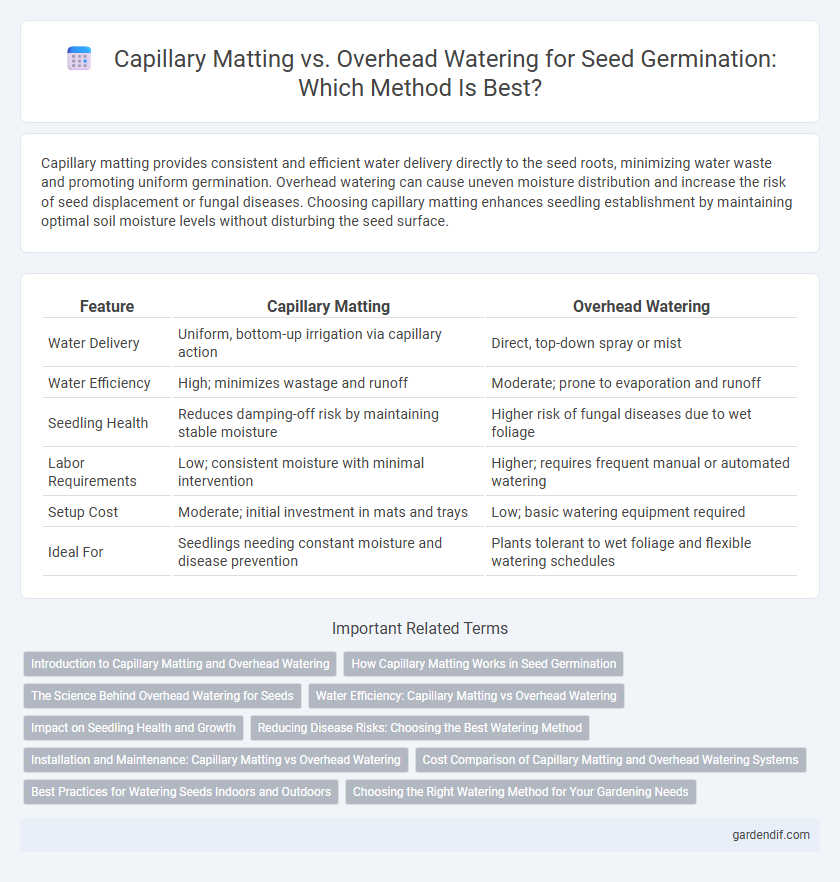
Capillary matting vs Overhead watering Illustration
Capillary matting provides consistent and efficient water delivery directly to the seed roots, minimizing water waste and promoting uniform germination. Overhead watering can cause uneven moisture distribution and increase the risk of seed displacement or fungal diseases. Choosing capillary matting enhances seedling establishment by maintaining optimal soil moisture levels without disturbing the seed surface.
Table of Comparison
| Feature | Capillary Matting | Overhead Watering |
|---|---|---|
| Water Delivery | Uniform, bottom-up irrigation via capillary action | Direct, top-down spray or mist |
| Water Efficiency | High; minimizes wastage and runoff | Moderate; prone to evaporation and runoff |
| Seedling Health | Reduces damping-off risk by maintaining stable moisture | Higher risk of fungal diseases due to wet foliage |
| Labor Requirements | Low; consistent moisture with minimal intervention | Higher; requires frequent manual or automated watering |
| Setup Cost | Moderate; initial investment in mats and trays | Low; basic watering equipment required |
| Ideal For | Seedlings needing constant moisture and disease prevention | Plants tolerant to wet foliage and flexible watering schedules |
Introduction to Capillary Matting and Overhead Watering
Capillary matting provides an efficient, water-conserving watering system by allowing seeds to absorb moisture directly through a porous surface, promoting uniform seedling growth and reducing water runoff. Overhead watering mimics natural rainfall by dispersing water droplets over seed beds but often results in uneven moisture distribution and increased evaporation. For seed germination, capillary matting offers targeted hydration and minimizes disease risk compared to the broad, less controlled application of overhead watering.
How Capillary Matting Works in Seed Germination
Capillary matting provides consistent moisture to seeds by drawing water from a reservoir and delivering it directly to the seed surface through capillary action. This method ensures even hydration without waterlogging, promoting optimal oxygen exposure and uniform seed germination. Compared to overhead watering, capillary matting reduces fungal risks and mechanical disturbance, enhancing seedling health and growth rates.
The Science Behind Overhead Watering for Seeds
Overhead watering relies on simulating natural rainfall, distributing water evenly across seed surfaces to promote uniform germination and reduce water stress. The science behind this method involves the gentle splash of droplets breaking soil surface tension, enhancing oxygen availability and preventing seed displacement. This contrasts with capillary matting, which provides moisture from below but may result in uneven hydration and limited oxygen flow to seedlings.
Water Efficiency: Capillary Matting vs Overhead Watering
Capillary matting delivers water directly to the seed roots through a porous surface, minimizing evaporation and runoff, resulting in superior water efficiency compared to overhead watering methods. Overhead watering often leads to significant water loss due to evaporation and uneven distribution, whereas capillary matting ensures consistent moisture levels ideal for seed germination and growth. This targeted approach conserves water resources and promotes healthier seed development by maintaining optimal soil moisture without excess water use.
Impact on Seedling Health and Growth
Capillary matting provides consistent moisture directly to seedling roots, promoting stronger root development and reducing the risk of diseases such as damping-off compared to overhead watering. Overhead watering often leads to uneven moisture distribution and increased leaf wetness, which can foster fungal infections and stunt seedling growth. Using capillary matting enhances overall seedling vigor by maintaining optimal soil moisture and minimizing stress from water fluctuations.
Reducing Disease Risks: Choosing the Best Watering Method
Capillary matting significantly reduces disease risks by delivering water directly to the seed's root zone, minimizing leaf wetness and the spread of fungal pathogens compared to overhead watering. Overhead watering often creates a moist environment on foliage, increasing susceptibility to diseases such as damping-off and fungal infections. Choosing capillary matting optimizes seed germination health by maintaining consistent moisture levels while limiting pathogen exposure.
Installation and Maintenance: Capillary Matting vs Overhead Watering
Capillary matting requires careful installation beneath seed trays to ensure uniform water distribution through the fabric, minimizing water waste and root disturbance. Overhead watering systems demand regular adjustment and monitoring to prevent soil erosion, fungal diseases, and uneven moisture levels caused by water droplets hitting the seedlings directly. Maintenance for capillary mats involves periodic cleaning and drying to prevent algae growth, while overhead watering needs frequent inspection of nozzles and pressure systems to maintain consistent water flow.
Cost Comparison of Capillary Matting and Overhead Watering Systems
Capillary matting systems typically have a higher upfront cost due to specialized materials and installation complexity, but they significantly reduce water usage and labor expenses over time. Overhead watering systems often involve lower initial investment but incur higher operational costs because of water waste, evaporation, and maintenance requirements. Considering long-term cost efficiency, capillary matting offers better value for controlled seed germination environments.
Best Practices for Watering Seeds Indoors and Outdoors
Capillary matting provides consistent moisture by allowing seeds to absorb water from below, reducing the risk of overwatering and promoting even germination indoors and in controlled outdoor settings. Overhead watering can lead to seed displacement and uneven moisture distribution, increasing the chance of disease and poor seedling development. Using capillary matting in propagation trays and combining gentle overhead misting for outdoor seedlings optimizes hydration while preventing water stress and fungal issues.
Choosing the Right Watering Method for Your Gardening Needs
Capillary matting provides consistent, even moisture directly to seed trays by drawing water from below, reducing the risk of overwatering and surface fungal diseases. Overhead watering mimics natural rainfall but can cause soil compaction and uneven seedling hydration, potentially leading to weak root development. Selecting the optimal watering method depends on seed type, container size, and humidity control requirements for optimal germination and healthy seedling growth.
Capillary matting vs Overhead watering Infographic

 gardendif.com
gardendif.com